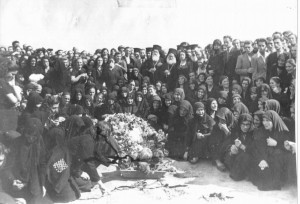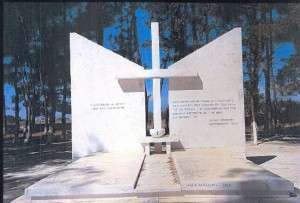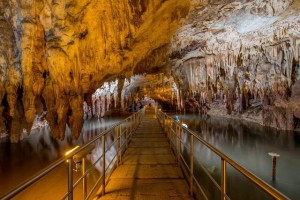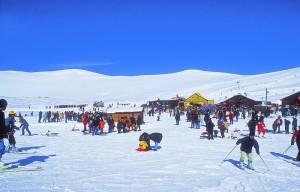1. MONUMENT OF SLAUGHTER IN DOXATO
September 29th, 1941
In 1941 Bulgarians conquered the historical village of Doxato. About 150 rebels coming from Doxato and the nearby villages organized a group in order to resist the Bulgarians’ occupation. On September 28th, 1941 the rebels attacked the Bulgarian mayor, policemen and rural constables. It was the first uprising in Greece during that period! They went to the police station, they lit a fire and they started shooting the policemen. According to a detailed survey, they managed to execute 35 Bulgarians and 12 cooperators in Doxato. The small group of rebels were not experienced and they did not predict the bad effects of their attack. The Bulgarian army reacted immediately in a hard way. On September 29th they attacked the local residents in about 50 areas of Drama and they executed 1,614 people, mainly men. In Doxato they arrested many innocent residents early in the morning. The residents from Doxato let their animals free because they were afraid of arsons. The Bulgarians were all around the village threatening, shouting and arresting men. They hit the arrested men with their guns violently. Bulgarians led some groups of the arrested men to the Primary School and afterwards to the so called area ‘’Pefkakia’’, a place full of pines. Elder people, women and children were jailed in the Primary School. In the evening the executions started. About 190 men from 16 to 65 years old were killed. A few managed to run away and escape. Eight days later residents from Doxato buried all the dead bodies in the same grave. It was one of the darkest days for the village!
From then on a memorial service is held to honor the executed men every year. Local people, relatives of the executed men, students, the police and the army take part in the memorial service which takes place at the area of the execution on September 29th .
Stella, class C1
Source http://www.sansimera.gr/articles/640
2. THE CAVE OF THE RIVER ANGITIS
The cave of the river Angitis is near the village Piges, 23km. away from the town of Drama. It is also called the cave of Maaras. There are two possible meanings of the word Maaras; it means the little cave in Arabic or the mountain water in Jewish. It was discovered by French speleologists in cooperation with the Greek Speleological Company in 1978. Bones of many animals have been found and have helped the scientists to conclude that these animals lived there 30,000 years ago. Findings have also shown that people lived in the area in the 4th millennium B.C. Some of the archaeological findings are at the Archaeological Museum of Drama.
The length of the cave is about 12km. but a visitor can only walk and see 500m. The beauty of the cave is unique because of the river Angitis, which flows through it, and the stalactites of various shapes and sizes. The temperature in the cave is always 17 degrees Celsius and the temperature of the water is 13 degrees Celsius. The first part of the cave is called the Wheel Chamber because there is an impressive water wheel. In the cave there are 37 animal species. 6 of them were known to the scientists for first time because of their existence in the cave. There are many fish, otters and bats.
A tourist can enjoy his visit in the cave and afterwards he can have a meal or a drink at the restaurant and the cafeteria near the cave. The environment is so beautiful and relaxing! The cave is open to visitors every day even on holidays! It’s worth visiting it!
Elina, class C1
Source http://www.kokkinogia.gr/index.php?option=com_content&task=view&id=575&Itemid=54
3.THE MOUNTAIN FALAKRO
In the north of Drama there is the mountain Falakro. It was also called the ‘’Boz daj’’ in the past , which means the Grey Mountain. It is about 45km. away from the town of Drama. It is 2,232 meters tall and it is the tallest mountain in eastern Macedonia and Thrace. In the west it is connected with the mountain Orvilos and in the east it ends up to the river Nestos valley. In the north it reaches Bulgaria.
In the mountain Falakro there is a ski center. In winter when there is much snow many tourists visit it and have fun. At the ski center there are twenty areas where the visitors can enjoy skiing. Moreover, visitors can stay at the hotel at night and enjoy the local food at the restaurant. Parking is available, too. There are also shops where skiers can rent the necessary equipment. Accommodation and local food are offered in the nearby villages, Volakas and Nevrokopi. So, if you are close to the mountain Falakro, don’t miss the chance to visit it and enjoy its snow!
Irene, class C2




 Time in Salonica
Time in Salonica 